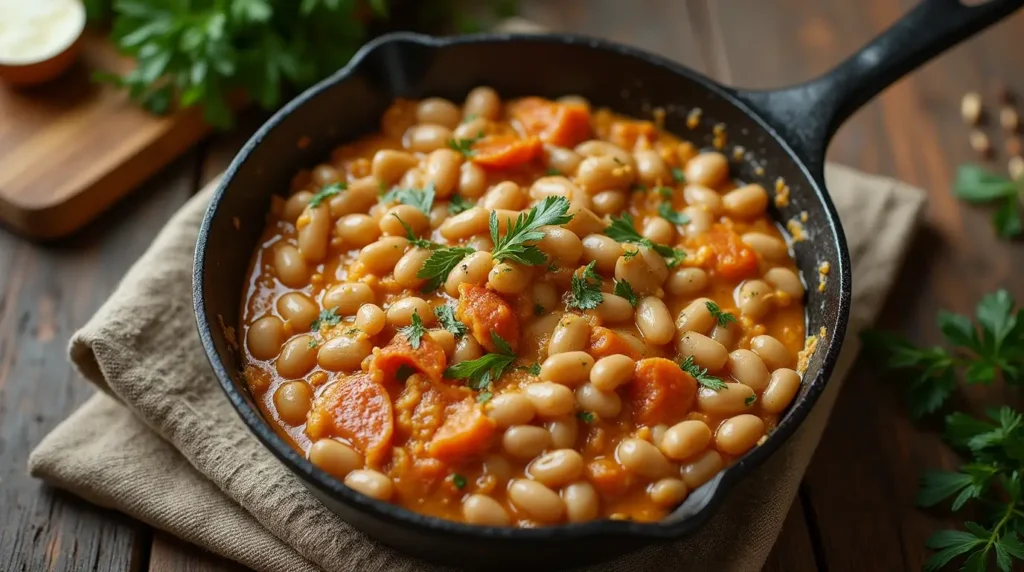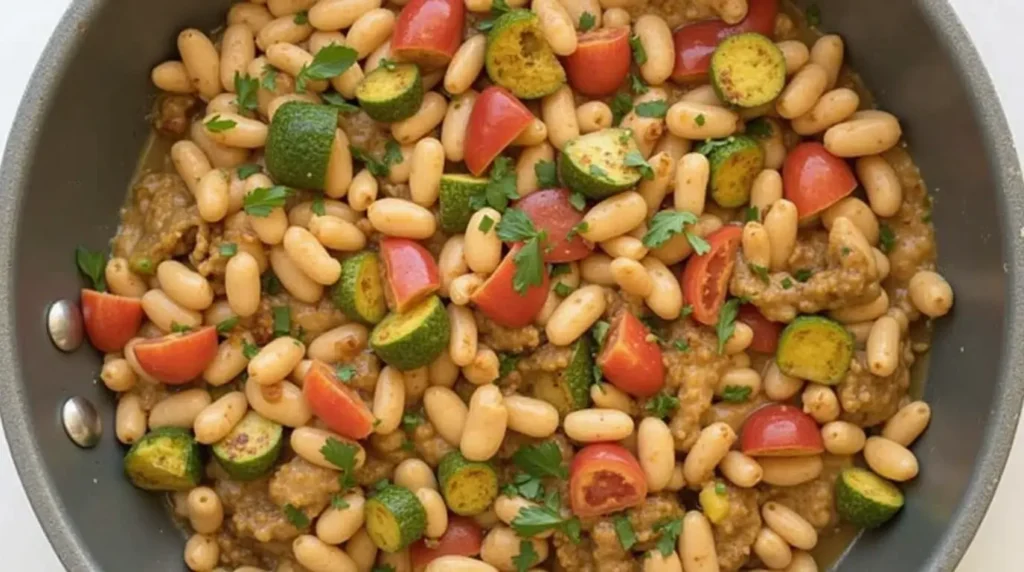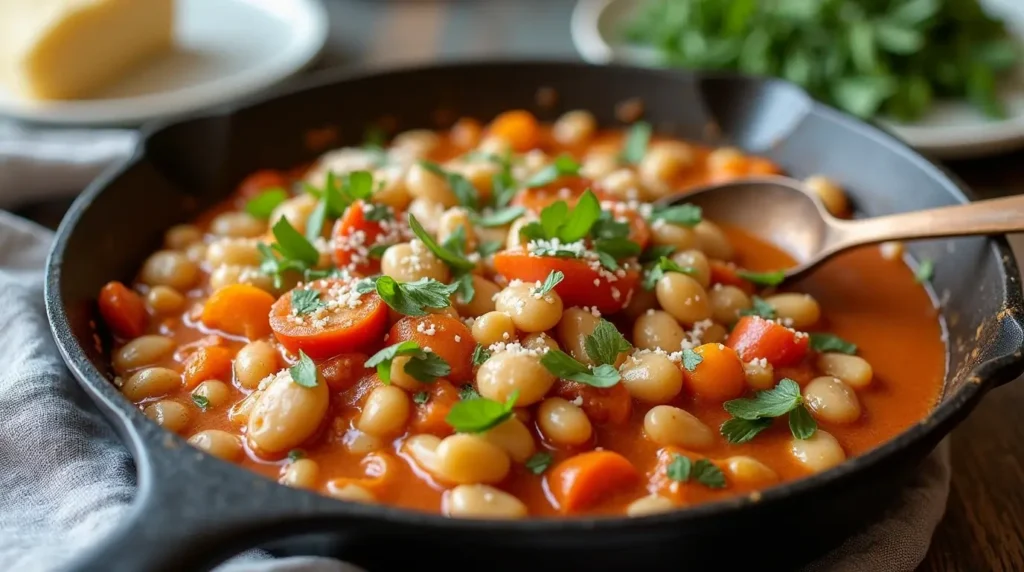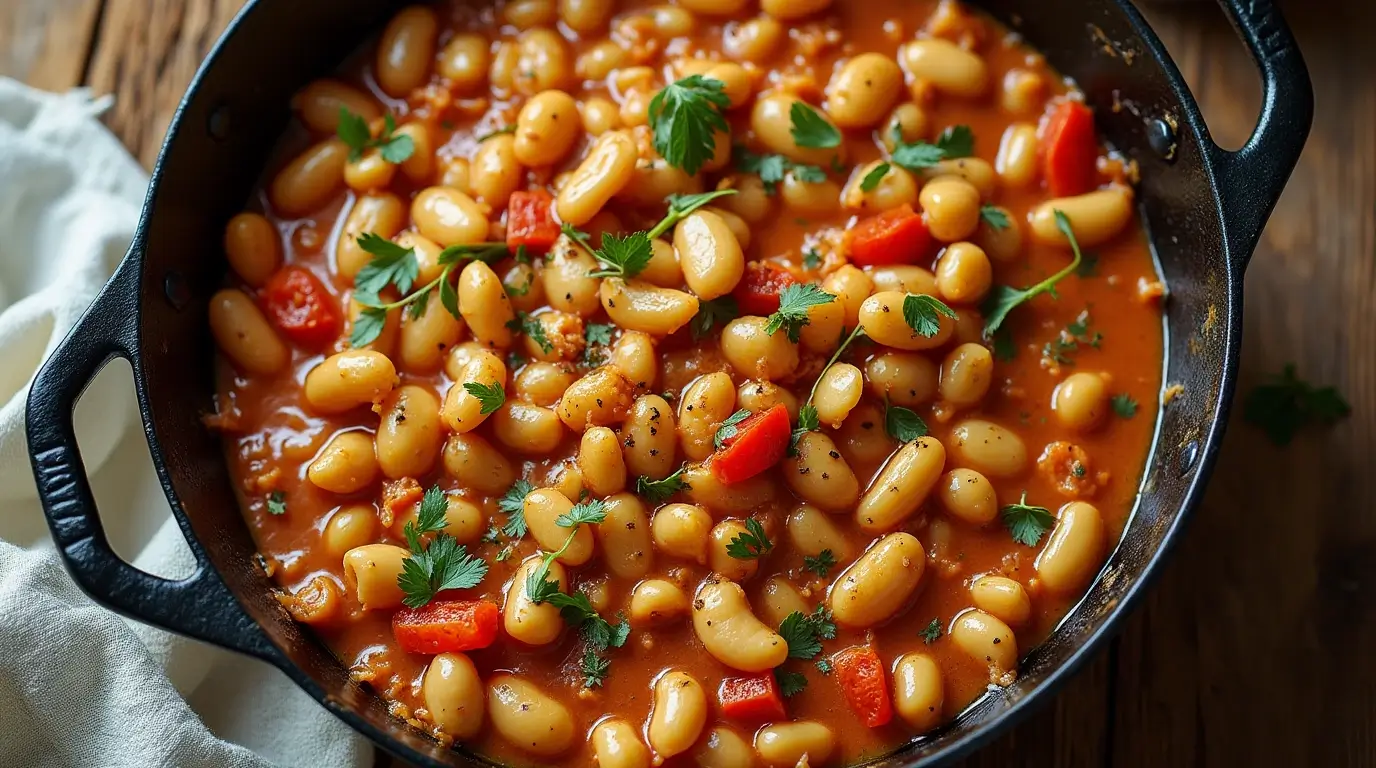This simple yet luxurious creamy Tuscan white bean skillet recipe creates a delightful dish, perfect for any occasion. Learn how to make this flavorful and satisfying meal.
The creamy Tuscan white bean skillet is a vibrant dish that combines the rustic charm of Tuscan cuisine with the satisfying comfort of a hearty meal. In this article, we’ll explore the intricacies of creating this delicious dish at home. Specifically, we will cover everything from ingredient selection to cooking techniques, ensuring you master this recipe. Furthermore, we will address common questions and provide tips for variations.
Understanding the Foundation: Key Ingredients for Your Creamy Tuscan White Bean Skillet
Essential White Beans: Choosing the Right Variety
Firstly, the foundation of any excellent creamy Tuscan white bean skillet is the type of white bean used. Cannellini beans are often preferred. However, Great Northern beans work equally well. These beans boast a creamy texture. Additionally, they hold their shape during cooking. This ensures a satisfying and rich consistency. Therefore, selecting fresh, high-quality beans is crucial.
PrintDelectable Creamy Tuscan White Bean Skillet: Your Ultimate Comfort Food
- Total Time: 25 minutes
- Yield: 3 servings 1x
- Diet: Vegan
Description
This creamy Tuscan white bean skillet is a one-pan, plant-powered meal packed with white beans, garlic, sun-dried tomatoes, and spinach—all simmered in a luscious, dairy-free or creamy sauce.
Ingredients
1 tablespoon olive oil
3 cloves garlic, minced
1 (15 oz) can white beans, drained and rinsed
1/4 cup chopped sun-dried tomatoes (oil-packed, drained)
1/2 teaspoon dried oregano
1/2 teaspoon crushed red pepper flakes (optional)
1/2 cup canned coconut milk or heavy cream
2 cups baby spinach
Salt and black pepper to taste
Optional: grated Parmesan or vegan cheese for topping
Fresh basil or parsley for garnish
Instructions
1. Heat olive oil in a large skillet over medium heat. Add garlic and sauté for 1 minute until fragrant.
2. Stir in white beans, sun-dried tomatoes, oregano, and red pepper flakes. Cook for 2–3 minutes, stirring occasionally.
3. Pour in coconut milk or cream and bring to a gentle simmer.
4. Add spinach and stir until wilted and the sauce thickens slightly, about 3–5 minutes.
5. Season with salt and pepper to taste.
6. Top with Parmesan or vegan cheese if using, and garnish with fresh herbs.
7. Serve warm with crusty bread, over rice, or on its own.
Notes
For extra protein, add sautéed mushrooms or a fried egg on top.
Use kale instead of spinach for a heartier green.
To make it vegan, choose coconut milk and skip the Parmesan or use a dairy-free alternative.
- Prep Time: 10 minutes
- Cook Time: 15 minutes
- Category: Main Course
- Method: Stovetop
- Cuisine: Italian-Inspired
Nutrition
- Serving Size: 1 1/2 cups
- Calories: 280
- Sugar: 3g
- Sodium: 460mg
- Fat: 15g
- Saturated Fat: 6g
- Unsaturated Fat: 8g
- Trans Fat: 0g
- Carbohydrates: 25g
- Fiber: 6g
- Protein: 9g
- Cholesterol: 0mg
Keywords: creamy tuscan white beans, vegan skillet dinner, white bean recipe, easy vegetarian meal
Aromatics: Enhancing Flavors with Garlic and Onions
Furthermore, aromatics play a vital role. The combination of garlic and onions creates a complex flavor profile. Firstly, sauté diced onions until translucent. Afterward, add minced garlic. Indeed, cook until fragrant, thus releasing their flavors. In addition, these steps are important for the overall taste. Consequently, they are not to be skipped.
Herbs: Infusing Tuscan Flavors
Another key element in the creamy Tuscan white bean skillet is the use of fresh herbs. Specifically, rosemary and thyme are quintessential to Tuscan cuisine. These herbs add depth. Moreover, they bring a unique fragrance to the dish. Alternatively, dried herbs can be used, but in smaller quantities. Consequently, adjust to your preference.
Cream: Achieving the Perfect Creamy Texture
Moreover, the creamy element is crucial. Heavy cream is the preferred choice for the creamy Tuscan white bean skillet. It adds richness and creates a luxurious texture. However, for a lighter option, you can use half-and-half. Additionally, a touch of cream cheese can enhance both creaminess and flavor.
Vegetables: Adding Color and Nutrition
Finally, fresh vegetables are an important component. Spinach or kale adds both color and nutrients. Sun-dried tomatoes, on the other hand, offer a burst of sweetness and acidity. Specifically, adding them at the end keeps them vibrant. Conversely, cooking them too long can make them mushy.
Step-by-Step Guide: Crafting Your Own Creamy Tuscan White Bean Skillet

Preparing the Ingredients: A Crucial First Step
Before starting, prepare all the ingredients. Measure everything accurately. This step will ensure a smooth cooking process. Specifically, dice the onions, mince the garlic, and chop your herbs. Also, rinse and drain the beans. Furthermore, chop any vegetables you plan to add.
Sautéing Aromatics: Building the Flavor Base
Firstly, heat olive oil in a large skillet over medium heat. Add the diced onions. Sauté until they become translucent. Next, add the minced garlic. Sauté until fragrant. Indeed, this step is crucial for developing a flavorful base. Furthermore, do not let the garlic burn.
Combining Beans and Aromatics: The Heart of the Dish
Once the aromatics are ready, add the cooked white beans to the skillet. Toss them gently to coat with the garlic and onion. Then, season generously with salt and black pepper. Additionally, consider adding a pinch of red pepper flakes. This will give a slight kick.
Adding the Cream and Herbs: Creating the Signature Creaminess
Furthermore, pour in the heavy cream or half-and-half. Stir well to combine with the beans and aromatics. Then, add the chopped fresh rosemary and thyme. Allow the mixture to simmer gently. This lets the flavors meld together.
Incorporating Vegetables: Bringing in Freshness
Finally, add any vegetables you are using. If using spinach or kale, add it towards the end. Specifically, when it wilts down, it is ready. Conversely, sun-dried tomatoes should be added in the last few minutes. This helps them retain their texture.
Simmering and Serving: The Final Touches
Allow the creamy Tuscan white bean skillet to simmer for a few minutes. This ensures all flavors are well combined. Taste and adjust seasoning as needed. Serve hot, garnished with extra herbs if desired. Furthermore, you can serve it on its own or with crusty bread.
Variations and Adaptations: Making the Dish Your Own
Vegetarian Options: Keeping it Plant-Based
The creamy Tuscan white bean skillet is naturally vegetarian. However, you can make it vegan. Substitute heavy cream with a plant-based cream. Likewise, nutritional yeast adds a cheesy flavor. Additionally, using vegetable broth in place of cream provides a lighter option.
Protein Additions: Enriching the Meal
For a heartier meal, consider adding protein. Grilled chicken or sausage pairs well. Moreover, crispy pancetta or prosciutto offers a salty touch. Additionally, shrimp can also be a great addition. Therefore, the protein you choose can change the flavor profile.
Spice Level Adjustments: Customizing the Heat
The standard recipe is mildly spiced. However, you can adjust the heat to your liking. Add extra red pepper flakes for a spicier kick. Moreover, a dash of hot sauce can provide extra flavor and heat. Conversely, you can leave out spicy ingredients entirely.
Cheese Options: Enhancing Creaminess and Flavor
While the recipe is fantastic on its own, adding cheese can make it even better. Parmesan cheese, for example, adds a savory note. Pecorino Romano cheese is another excellent choice. Specifically, sprinkle cheese over the top before serving. Consequently, melting it slightly will give an additional layer of richness.
Using Different Types of Beans: Exploring New Textures
While cannellini beans are preferred, other white beans will also work. Great Northern beans are another good choice. They are similar in texture. Moreover, butter beans offer a creamy and smooth texture. Therefore, using different beans can give unique outcomes.
Serving Suggestions: Pairing Your Creamy Tuscan White Bean Skillet

Bread Pairings: Perfect Accompaniments
Serve the creamy Tuscan white bean skillet with crusty bread for dipping. Additionally, focaccia or ciabatta are great options. Furthermore, garlic bread adds extra flavor. Therefore, bread is ideal for soaking up the delicious sauce.
Salad Sides: Adding Freshness
A light, fresh salad complements the richness of the skillet. For example, a simple arugula salad with lemon vinaigrette works well. Also, a cucumber and tomato salad offers a crisp contrast. Consequently, salad adds a touch of lightness to the meal.
Wine Pairings: Elevating the Dining Experience
Pair your creamy Tuscan white bean skillet with a crisp white wine. A Pinot Grigio or Sauvignon Blanc is a great choice. These wines have a refreshing acidity. In addition, a light-bodied red like Chianti also pairs well. Consequently, wine can enhance the flavors of the dish.
Other Main Course Pairings: Expanding the Meal
This dish can also serve as a side. For example, alongside roasted chicken or grilled fish, it is perfect. Therefore, it is versatile enough to fit into various menus. Additionally, the creamy Tuscan white bean skillet also works well with other Italian dishes.
Garnishing Ideas: Adding Visual Appeal
Garnish your creamy Tuscan white bean skillet for extra visual appeal. Fresh herbs, such as rosemary and thyme, are always a great choice. Furthermore, a drizzle of high-quality olive oil will add flavor. Moreover, a sprinkle of red pepper flakes adds color. Consequently, garnishing enhances the presentation.
Common Mistakes to Avoid: Achieving Perfection with Every Batch
Overcooking the Beans: Maintaining Texture
Avoid overcooking the beans. Overcooked beans can become mushy. Therefore, be gentle when stirring. Always use properly cooked beans for best results. This will ensure the desired creamy texture. Additionally, be careful to not add too much liquid.
Burning the Garlic: Keeping Aromatics Balanced
Burned garlic can ruin the entire dish. Sauté the garlic over low to medium heat. Ensure it is fragrant but not browned. Therefore, pay close attention during this step. Similarly, overcooked garlic will develop a bitter flavor.
Skimping on Seasoning: Enhancing Flavors
Do not skimp on the seasoning. Generously add salt and pepper. Taste as you go. Adjust as needed. Furthermore, adding enough seasoning will bring out all the flavors. Therefore, a well-seasoned dish is always more flavorful.
Using Low-Quality Ingredients: Impact on Taste
Always use high-quality ingredients. This especially applies to fresh herbs. Furthermore, fresh ingredients enhance the taste significantly. In addition, good-quality beans will make a difference. Consequently, using quality ingredients is worth the effort.
Adding Cream Too Early: Preventing Separation
Add the cream at the right time. Adding it too early can cause it to separate. Specifically, add it when the beans are heated. Stir it gently and consistently to prevent separation. This ensures a smooth sauce. Also, do not boil the cream.
Storing and Reheating: Making the Most of Your Creamy Tuscan White Bean Skillet
Proper Storage: Ensuring Freshness
Store any leftover creamy Tuscan white bean skillet in an airtight container. Keep it in the refrigerator. It will stay fresh for up to three days. Moreover, ensure the container is tightly sealed. This helps prevent it from drying out.
Reheating Methods: Maintaining Quality
Reheat your creamy Tuscan white bean skillet on the stovetop. Add a splash of water or broth. Heat gently over medium-low heat. Also, stirring regularly to ensure it heats evenly. Furthermore, avoid boiling to prevent the cream from separating.
Freezing Option: Longer-Term Storage
While it is best enjoyed fresh, you can freeze this dish. Allow it to cool completely. Then, transfer it to a freezer-safe container. Therefore, it can stay frozen for up to two months. Thaw it overnight in the refrigerator before reheating.
Taste and Texture: Considerations When Reheating
Note that the texture may slightly change upon reheating. Specifically, it may not be as creamy. However, adding a little extra cream or broth can help restore it. Consequently, adjusting the texture upon reheating will improve the outcome.
Serving Leftovers: New and Creative Ways
Transform leftover creamy Tuscan white bean skillet. Use it as a filling for wraps or sandwiches. Additionally, add it to pasta or grain bowls. Therefore, get creative and enjoy the dish in many ways.
The Nutritional Benefits of a Creamy Tuscan White Bean Skillet

High in Fiber: Promoting Digestive Health
White beans are an excellent source of fiber. Fiber promotes digestive health. It also helps maintain blood sugar levels. Specifically, it keeps you feeling full for longer periods. Additionally, it is vital for overall well-being.
Rich in Protein: Supporting Muscle Growth
Furthermore, white beans are rich in protein. This is especially beneficial for vegetarians and vegans. Protein is essential for muscle growth. Moreover, it plays a crucial role in cell repair. Therefore, including protein in every meal is important.
Packed with Vitamins and Minerals: Enhancing Overall Health
Also, this dish is packed with essential vitamins and minerals. Spinach and other vegetables contribute to your daily vitamin intake. The combination of these nutrients is crucial. It also supports overall health and well-being.
Healthy Fats: Providing Energy and Support
Olive oil and cream provide healthy fats. These are essential for energy and overall body function. However, you can use healthier alternatives. For instance, using less cream will reduce fat content. Therefore, consider your health goals when making this dish.
Low Glycemic Index: Keeping Blood Sugar Stable
Finally, white beans have a low glycemic index. This means they do not cause rapid spikes in blood sugar. Therefore, it’s a great option for those managing blood sugar levels. Additionally, the combination of beans, vegetables, and fats is great for glycemic control.
Discover great ideas like Fruity Pebbles Cookies – The Ultimate Colorful & Crunchy Delight for more sweet inspirations.
Frequently Asked Questions: Addressing Your Queries
Is a creamy Tuscan white bean skillet suitable for a slow cooker?
A creamy Tuscan white bean skillet can be adapted for a slow cooker. However, the texture might be different. First, sauté the aromatics before adding them. Then, combine all ingredients in the slow cooker. Cook on low for 4-6 hours. Lastly, add the cream in the last 30 minutes.
Can I use dried beans for a creamy Tuscan white bean skillet?
Yes, you can use dried beans. However, you will need to soak them first. Soak them overnight. Then, cook them until tender. This method adds more flavor. Furthermore, it ensures the beans are perfectly cooked. Therefore, planning is important.
What is the best way to store leftovers of a creamy Tuscan white bean skillet?
Store leftovers in an airtight container in the refrigerator. They stay fresh for up to three days. Ensure the container is well-sealed to prevent drying. Also, avoid storing them when hot to reduce condensation.
Can I make this creamy Tuscan white bean skillet vegan?
Yes, you can make a vegan creamy Tuscan white bean skillet. Substitute the heavy cream with a plant-based cream or coconut milk. Moreover, use nutritional yeast for a cheesy flavor. Additionally, ensure all other ingredients are vegan.
How can I make the creamy Tuscan white bean skillet spicier?
To make it spicier, add red pepper flakes. Also, you can add a dash of hot sauce. Moreover, include a spicy pepper while sautéing the aromatics. Experiment until you achieve the desired heat level. Furthermore, remember you can always add more.
Is a creamy Tuscan white bean skillet similar to creamy Tuscan white bean soup?
While similar, a creamy Tuscan white bean skillet is thicker. Creamy Tuscan white bean soup usually has more broth. The skillet version has less liquid. Therefore, the texture is different. However, the flavors are still similar.

